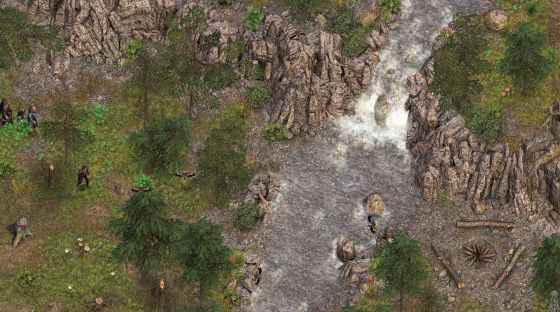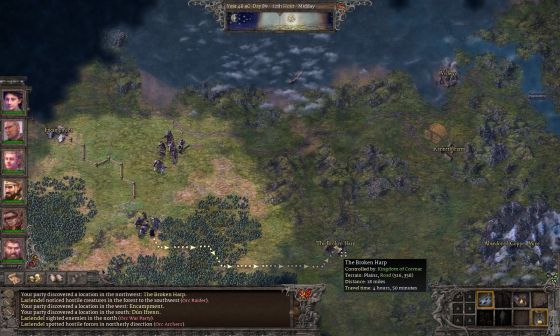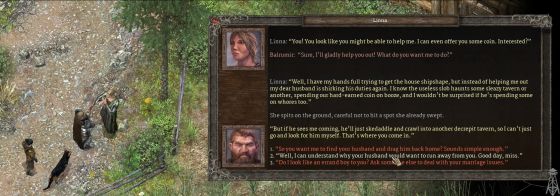Realms Beyond is a classic party based open-world RPG (with no level scaling) inspired by, amongst others, the old Gold Box games and
Ultima 7. At the start of the game, you get to create your first character, using the classic classes: Barbarian, Cleric, Druid, Fighter, Monk, Paladin, Ranger, Rogue and Wizard, from seven possible races: Dwarf, Elf, Gnome, Half-Elf, Half-Orc, Halfling and Human.
Realms Beyond is based on the D&D 3.5 System Reference Document that cannot be found on the Wizards of the Coast website anymore, but by googling it, you can still find the document, if you are interested in those details.
In the game, you will meet other characters that can join your party. At that point, you can decide to use that character or create another character from scratch. This means that you can end up with a party that is completely created by you. There can be a total of six characters in your party.
Realms Beyond uses the assets of
Chaos Chronicles, which they managed to acquire after the bankruptcy of BitComposer. The engine that is used in Realms Beyond is based on the same engine as the one used in the
Spellforce games and
Chaos Chronicles.

You start in the world of
Realms Beyond, where some 50 years ago a global disaster happened, called the cataclysm. Simultaneously everywhere in the world, volcanos erupted. Some areas were destroyed immediately and now lie in ruins. Nobody actually knows what really happened. Since then the world is somewhat in chaos and every culture and nation have created their own explanation about the cataclysm. Some think there is a religious reason, some think it is a demon, some a wizard, but nobody really knows.
It is your task to travel the entire world and collect the necessary information from the various nations and cultures, by means of completing quests and finding hints to solve the mystery. For this, you have to deal with the sensitivities of those different cultures and deal with a new cult, named the cult of the Inner Flame. A religious cult of which the popularity is rising in the world.
All items in the game are in-game items and they can all be interacted with. For the hoarders amongst you that means, if you are not careful, you might end up with a lot of junk, but if you want to do that, you can. The items add a lot of detail to the world, just as it did in Ultima 7, which was named a few times during the presentation. Most of the items have however no relevance to the gameplay, but might be relevant to the NPCs. A baker needs items for baking, a blacksmith needs items for smithing, etc. These items are not useful to you as a player, but they are to them. In this way, they want to make the world more believable. Sometimes an item or object can be inspected further. In those situations the mouse cursor will change to indicate that. Given the amount of items in the world that is probably a good idea.
With all the stuff lying around you might think about stealing it, but if someone notices you doing that you might get into trouble. First you get into trouble with only the NPC. When words get around you could get into trouble with the other people in the village and after that perhaps in the kingdom and even in the whole game world. If you are not noticed, but word does get around that there is a thief, the town guards might want to see your equipment to search for stolen goods. Any stolen items you might have are tagged as stolen and those tags can only be removed by finding a merchant who is willing to deal in stolen goods.
Adding to the believable world they are trying to create, is the day/night cycle and that the NPCs have schedules. When you enter a city at night, people will be in their homes and their shops are closed. Unfortunately this is not implemented yet, so it could not be shown, but it is something that will be implemented in a later version.
When you do enter a house, there will be no loading of a new scene, instead the roofs of the houses simply disappear, so that you can see inside the house.

On the world map you can see your party and its location in the world. When you are not moving, nothing happens, but when you start moving other enemy groups will start moving on the map as well. The map is using a hex grid and you can see a few hexes around your party to detect if there are any enemy groups that you might want to avoid. At night however that distance is greatly reduced as you cannot see as well as you can during day time. The distance you can see depends on your character skills.
Each hex on the map is generated using the actual world contents, so it will resemble the environment in the world as good as possible. Each hex on the map is about 2 miles and the complete world is 2.000 square miles, which means there are a million hexes in total.
The map actually consists of two separate parts integrated into one. One contains the encounters, where events are generated from pre-defined templates. These have no content other than the environment needed for the combat. The second contains the pre-made locations that are identified on the map by the fact that they have a name. Here you find the cities, villages and dungeons. Those locations have content and could consist of multiple levels. The engine supports a total of 200 levels, but they have no plans at the moment to create a mega dungeon of that size. The locations on the map will also show what faction is in control of the location and whether or not it is a friendly faction. In addition, also the travel time to that location is shown.
When you travel the time on the map moves as well. It takes about an hour and a half to walk ten miles, but it all depends on where you are traveling. If you are using the roads, you can travel a lot faster compared to traveling through the forest, so you have to take that into account when you leave the roads. Another way of traveling is by boat, which can be used to travel to one of the islands on the map. Clicking on a location on the map will make you rparty enter that location when they reach it. This happens with almost no loading time, which is quite impressive.
Whenever there is an encounter on the world map, text is shown that not only states there is an encounter, but it will also take the position on the map where you currently are and use that in the text to be displayed, to get to something like this: "An orc raiding party has ambushed you near the coast line during day time". The details of the orc raiding party will also be available in additional text. The displayed text will be different if you are in the forest or in the mountains. By using this in-game data for presenting information to the player, they want to achieve a more engaging experience. The next screenshot will give you an idea of what the map looks like.

The map will have hidden locations that you can only find when you follow a trail. You could for example, get a message that a corpse is found near the side of the road, with tracks leading away from that corpse. By investigating the matter, you could then get the question if you would like to follow the tracks into the forest. If so, you follow them and a new location will pop up, like a witch cabin, or something like that. This cabin would not be visible by just walking around on the world map.
There will be hidden treasures that you can find by collecting pieces of a treasure map that are scattered throughout the region where you are in. These are randomly placed and will be at a different location for everyone. Once you have all parts of the map collected, a treasure location will show up on your map, where you can go, to collect the treasure.
Your party will not only need to rest, but needs to eat and drink as well. This is achieved by setting up a camp. If you have food like onions, potatoes and carrots in your inventory and have the tools needed for cooking, like a pan, someone in your party with a cooking skill can prepare a meal for the party. The ingredients of the meal are removed automatically from your inventory and the cooking is automated well, as long as everything is in place for this. The result of the cooking exercise is shown as text on the screen, like "Waldo created a delicious meal for the party" and a bonus is awarded to the party for having the meal. Obviously, in order to cook, you need wood for making a fire. Wood will be collected automatically when you are near a forest, but if you camp in a barren area, you should be prepared and carry a supply of wood with you in order to be able to cook.
Whenever you have an encounter on the world map, the game switches seamlessly from moving in real-time to turn-based combat. A hex grid is displayed, showing where each of the characters can go. The combat is what you expect from D&D 3.5, so I will forward you to a combat video of the game. It is a lengthy video, but you will get the gist of things after a few minutes.
Realms Beyond - Combat Alpha 1 Gameplay
The developers looked at
The Temple of Elemental Evil for inspiration when implementing the combat.
One of the philosophies the developers have in making the game is that they want to restrict the player as little as possible in their exploration activities in the game. The player needs to make his or her own choices and live with the consequences of those choices, but it is needed to have the right skills in order to explore in a proper way. With the right skill you could, for example, detect herbs and harvest them. If you do not have that skill, the characters in your party will not recognize the herbs, which stops you from harvesting them.
With choices and consequences comes a branching quest system, which they use to have your choices have an impact in the world. Actually, your actions, both inside and outside of quests, can have consequences in the world. If you would destroy a goblin camp somewhere and kill all the goblins, it might be that after some time, humans will claim that spot, because the goblins are no longer there. You can make entire regions safer for humans in this way, but you can also choose not to.
And if you are lost, and like to know what quest you are doing now, you should be aware that the game does not have a quest compass or quest markers hovering over people's had or hovering anywhere else for that matter. Any information you need about quests can be read from the journal, which is automatically filled with information as you go along.

There is also a branching dialog system. Conversations can have different outcomes depending on your choices. In addition, some branches in conversations are based on your race, gender, class, or what you have done up to that point. This can also happen with merchants, who might not want to help you because they don't like humans, dwarves or something like that.
NPCs you encounter in a village will be talking to each other and you can listen to their conversations. The text they use can be just random talk, but can also depend on your previous actions. If you would have cleared that goblin camp, you might hear them talk about a group of heroes who finally killed the goblins. This again, is meant to make the world more real.
Realms Beyond will support alignment, but their their implementation of alignment is different from the D&D version, as they wanted something more intricate. They plan to use a diagram where different character traits are available and each character will align more or less with each of these traits. Like, being greedy, lazy, sneaky, open-minded, etc. As it is still in development, this could not be shown.
How this works in the game is that if you have a greedy character and you let that character barter with a merchant, it will probably not be a success, as the greedy character will not part from money or items easily and it is very unlikely that they will come to an agreement. So perhaps a greedy person is not the best person to barter with a merchant.
Also the armor class is a bit different from D&D. In D&D you only have armor for the torso. They have changed this and distributed the armor class from D&D over different armor parts for the helmet, body, gloves and boots. If they are all of the same type then together they would give the same armor class as the armor in D&D would.
The game will support a faction system on different levels. One town is a faction, one kingdom is a faction and then there are global factions, such as a merchant gild, or factions based on a race or religion. You can align yourself with factions, but some factions are opposite to each other, so befriending one faction, could mean you become an enemy of another faction. You can for example, align with the orcs, but in order to do that you have to kill humans, who will not think kindly of you because of that. If you make a character angry, because of your actions or conversations, it will spread out to the faction that character belongs to, like the village or camp.

Quite some time has been spent on creating the tools needed to create the game. The developers have done that early in development, to make the creation of the content in the game faster. For the modders, it is good to know that these tools are made available when the game launches, so people can create their own mods, or as almost everything in the game is scripted, the game itself can be changed.
The game is currently in pre-alpha, but was shown to me in the presentation that laster more than an hour, it is clear that they have a lot available. There are already loads of spells, items, weapons and armor available. Large sections of the world were available, but lacking content. The game engine and graphics are close to completion as are most of the assets.
What they are really missing at the moment is content in the form of dialogs, quests and other pieces of text. This is also one of the reasons that they are going to Kickstarter to get sufficient funds to be able to hire extra people who can work on the creation of the content. The second reason is that they want to learn how many people are actually interested in a hard-core RPG like Realms Beyond.
The plan is to release the game at the end of 2019 or the beginning of 2020 and will be released in parts, meaning that only a part of the map will be available at that time. A total of 3 parts are planned. The second and third part will be much lower priced than the first part and will come in the form of expansions to that first part. They are doing this, because they will need the time to create the content for all the parts and in this way the game can already be made available for a large part. The mod tools will be released with the first part, so people can already start creating mods for the game.
I was impressed with what I was shown and look forward to seeing more. I don't know how big the market is for a classic RPG like this, but I hope it is big enough to realize all parts of the game and make it a success, as what I got to see looked very promising.






















 They won best booth too and that says a lot about their focus on details but why, Why, WHY??? is this information on some other site okay?
They won best booth too and that says a lot about their focus on details but why, Why, WHY??? is this information on some other site okay?  Look even this
Look even this 


















